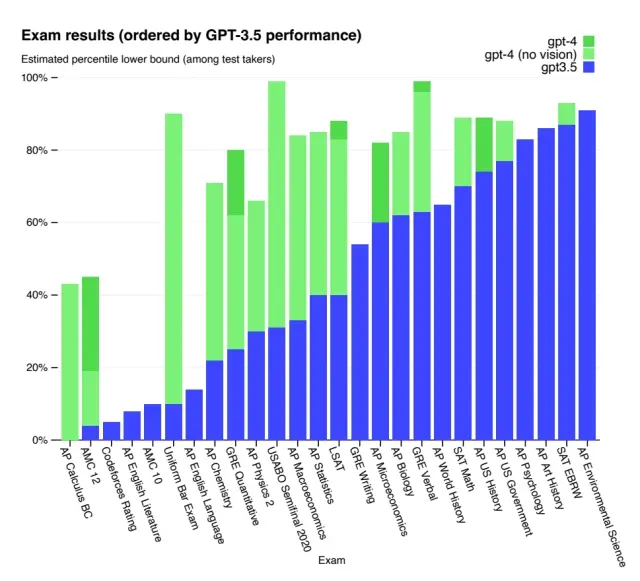
Since its launch in December 2022, ChatGPT has become a household name on the internet, attracting 1.8 billion visitors per month and reaching new milestones regularly. But what exactly is this ChatGPT phenomenon? To provide a comprehensive understanding, we’ve put together an in-depth explainer covering what ChatGPT is, who developed it, its features, and more.
What Is ChatGPT?
ChatGPT is an AI-powered chatbot developed by OpenAI. It functions as a platform where users can interact with an AI model, known as a Large Language Model (LLM). The term “chat” refers to its conversational capabilities, while GPT stands for Generative Pre-trained Transformer, a specific type of LLM. We will delve into GPT in more detail shortly.

At present, ChatGPT provides access to two AI models: GPT-3.5 and GPT-4. Both models have been developed in-house by OpenAI and are not open-source. GPT-3.5 is available for free to all users, while GPT-4 is accessible only to subscribers of ChatGPT Plus. Although both models excel in conversational abilities and context understanding, GPT-4 is the most advanced and capable LLM available today.
To give a brief overview, GPT-3.5 is trained on 175 billion parameters, whereas GPT-4 is trained on a staggering 1 trillion parameters, enhancing its capabilities significantly. For comparison, Google’s PaLM 2 AI, another leading LLM, has around 540 billion parameters, making it large but still smaller than GPT-4. Additionally, GPT-3.5 has a maximum context length of 4096 tokens, while GPT-4 can handle up to 32,768 tokens. Context length refers to the amount of information a model can process and generate.
GPT Meaning: Explained
As mentioned earlier, GPT is a type of Large Language Model (LLM) that has revolutionized generative artificial intelligence. It is built on the transformer architecture, which is trained on extensive text data to produce human-like text. Surprisingly, significant contributions to the GPT architecture originated from Google.
In 2017, Google researchers published a groundbreaking paper titled “Attention is All You Need,” which introduced the Transformer model (the “T” in GPT).

The “Attention” mechanism introduced in this paper is crucial for large language models, as it enables them to predict the next word in a sentence while maintaining context. This mechanism allows the model to focus on different parts of the input and generate each element of the output sequence. Unlike human language understanding, which relies on natural comprehension, these models predict words based on patterns, statistical inferences, and the data they have been trained on.
In summary, the Generative Pre-trained Transformer (GPT) architecture underpins all major Transformer models, including ChatGPT 3.5 and 4. It has made significant advancements in natural language processing and continues to push the limits of artificial intelligence.
Who Developed ChatGPT?
ChatGPT was developed by OpenAI, an American company founded in 2015 as a non-profit, open-source organization. The company was founded by a group of AI scientists and investors, including Sam Altman, Elon Musk, Ilya Sutskever, Andrej Karpathy, and others. In December 2022, OpenAI released a free preview of ChatGPT based on the GPT-3.5 model.

OpenAI has since transitioned from a non-profit to a “capped” for-profit model and has partnered with Microsoft, which initially invested $1 billion. In January 2023, Microsoft announced a significant increase in its commitment, investing an additional $10 billion in OpenAI to support further research and development.
Best Features of ChatGPT
First and foremost, ChatGPT, including both the GPT-3.5 and GPT-4 models, is known for its high level of creativity. It excels in natural language processing and maintains context effectively. The models are capable of a wide range of creative tasks, from writing poems and stories to generating imaginative ideas and complex explanations. However, GPT-3.5 is prone to “hallucinations,” meaning it sometimes generates information that is inaccurate or fabricated, providing data that doesn’t actually exist.

In this regard, GPT-4 significantly outperforms GPT-3.5. In factual evaluation tests, GPT-4 scored 40% higher than GPT-3.5 across various categories. For research purposes, it’s highly recommended to subscribe to ChatGPT Plus, which costs $20 per month and provides access to the GPT-4 model.
Additionally, GPT-4 has excelled in numerous academic and professional exams, including the SAT, GRE, Uniform Bar Exam, USMLE, Leetcode, and more. It also demonstrates strong capabilities in coding, reasoning, comprehension, and solving complex mathematical problems.

Additionally, GPT-4 now features internet access through integration with Bing, allowing it to retrieve the latest information on any topic using Microsoft’s Bing search engine. This feature is not available with the free GPT-3.5 model, which has a knowledge cut-off date of September 2021.
You can also enhance the functionality of the AI chatbot with ChatGPT Plugins. These plugins allow you to integrate third-party services directly with ChatGPT, enhancing its functionality. Whether you want to book flight tickets or summarize YouTube videos, Plugins offer a wide range of possibilities. To learn how to enable and use ChatGPT Plugins, refer to our linked tutorial.

Additionally, the Code Interpreter Plugin allows you to run Python code directly within ChatGPT, effectively giving you your own shell inside the platform. However, it’s important to note that this feature is not currently available to all users.
Furthermore, GPT-4 is a multimodal model, meaning it can analyze both text and images. While this feature has not yet been integrated into ChatGPT, it promises to revolutionize how we interact with AI models. In the future, you might be able to use ChatGPT to draw insights from medical reports, obtain nutritional information from images, and more. The upcoming GPT-5 model is expected to be even more powerful and feature-rich.
What Can You Do With ChatGPT?
ChatGPT offers limitless possibilities. You can use it to write stories and poems, generate music chords, debug and write code, explain abstract concepts, solve mathematical and reasoning problems, and much more. It’s also increasingly popular for tasks like writing essays and planning travel. We have an extensive list of exciting things you can do with ChatGPT.

In addition to its many uses, you can also leverage ChatGPT to generate income. Opportunities include creating apps and websites, engaging in affiliate marketing, writing e-books, starting an online business, and more. You can even build a custom AI chatbot tailored to your own data.
For programmers, ChatGPT is useful for writing code in VS Code and other IDEs, as well as identifying and fixing errors. Having used ChatGPT for various tasks over the past several months, I’ve consistently been impressed with its capabilities.
How to Use ChatGPT in 2024
To use ChatGPT, visit chat.openai.com and create a free OpenAI account. Once you sign in, you can chat with the free GPT-3.5 model without any limitations.

For more advanced capabilities, I recommend subscribing to ChatGPT Plus, which provides access to the powerful GPT-4 model.

If you prefer not to pay $20 per month, you can access GPT-4 for free through Bing Chat and other third-party services. Bing AI Chat (“Creative mode”) is powered by GPT-4 and offers a longer context window. You can use Bing AI Chat in any web browser of your choice.

Top ChatGPT Alternatives
If you’re interested in exploring alternatives to ChatGPT, you might start with Google Bard. Bard AI, based on Google’s latest PaLM 2 model, is similar to ChatGPT but not as advanced as GPT-4. Nonetheless, Bard performs well for many tasks. Another option is Bing AI Chat, which uses GPT-4 and allows for 300 chats per day (30 per session).

You can also consider Anthropic’s Claude AI, a competitor to ChatGPT that features a remarkable 100K token context window, an attribute not found in ChatGPT or other LLMs. For more free ChatGPT alternatives, check out our linked article.




